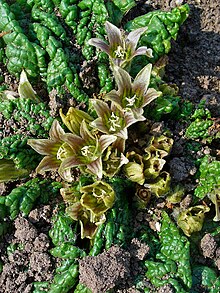| Mandragora officinarum | |
|---|---|

| |
| Scientific classification | |
| Kingdom: | Plantae |
| Clade: | Tracheophytes |
| Clade: | Angiosperms |
| Clade: | Eudicots |
| Clade: | Asterids |
| Order: | Solanales |
| Family: | Solanaceae |
| Genus: | Mandragora |
| Species: | M. officinarum
|
| Binomial name | |
| Mandragora officinarum | |
| Synonyms[1] | |
|
(Based on a broad circumscription of M. officinarum)
| |
Mandragora officinarum is the type species of the plant genus Mandragora in the nightshade family Solanaceae.[2] It is often known as mandrake, although this name is also used for other plants. As of 2015[update], sources differed significantly in the species they use for Mandragora plants native to the Mediterranean region. The main species found around the Mediterranean is called Mandragora autumnalis, the autumn mandrake. In a broader circumscription, all the plants native to the regions around the Mediterranean Sea are placed in M. officinarum, which thus includes M. autumnalis. The names autumn mandrake and Mediterranean mandrake are then used.[3] Whatever the circumscription, Mandragora officinarum is a perennial herbaceous plant with ovate leaves arranged in a rosette, a thick upright root, often branched, and bell-shaped flowers followed by yellow or orange berries.
Because mandrakes contain deliriant hallucinogenic tropane alkaloids (atropine, scopolamine, and hyoscyamine) which cause delirium and hallucinations,[2] and the shape of their roots often resembles human figures, they have been associated with a variety of religious and spiritual practices throughout history.[2] They have long been used in magic rituals,[2] today also in contemporary Pagan practices such as Wicca and Heathenry.[4] However, the so-called "mandrakes" used in this way are not always species of Mandragora let alone Mandragora officinarum; for example, Bryonia alba, the English mandrake, is explicitly mentioned in some sources.
- ^ Cite error: The named reference
Ungr98was invoked but never defined (see the help page). - ^ a b c d Kennedy, David O. (2014). "The Deliriants - The Nightshade (Solanaceae) Family". Plants and the Human Brain. New York: Oxford University Press. pp. 131–137. ISBN 9780199914012. LCCN 2013031617.
- ^ Cite error: The named reference
GRINwas invoked but never defined (see the help page). - ^ John Gerard (1597). "Herball, Generall Historie of Plants". Claude Moore Health Sciences Library. Archived from the original on 2012-09-01. Retrieved 2012-02-22.